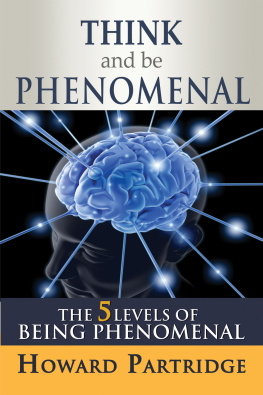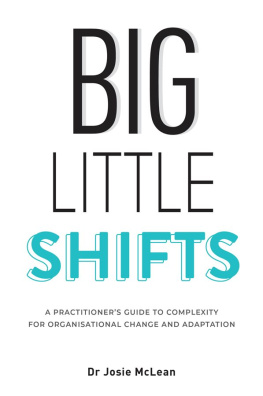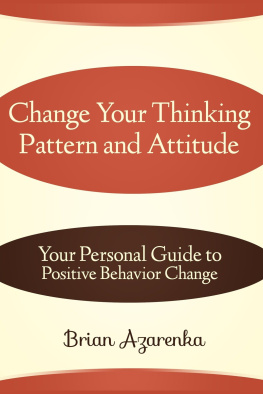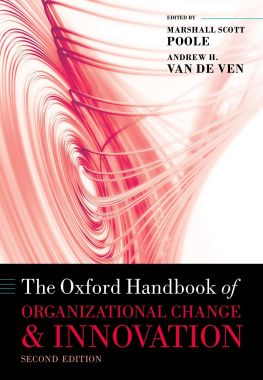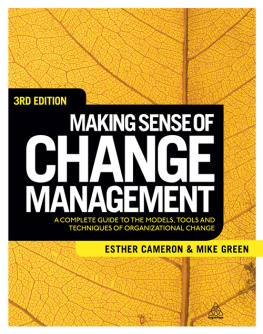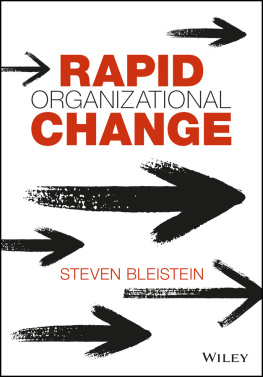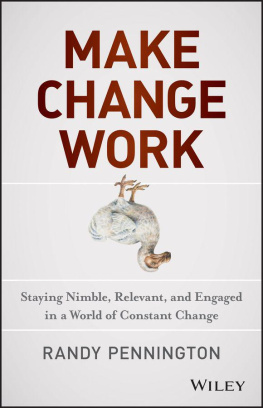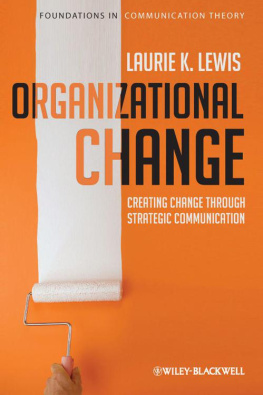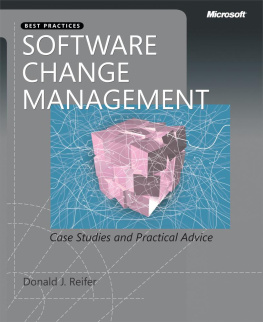Praise for 7 Rules for Positive, Productive Change
Esther Derby has written a must-read guide for anyone whose organization is experiencing a complex shift.... Read this bookand learn from one of the best.
Howard Sublett, Chief Product Owner, Scrum Alliance
This book is a product of Esthers hard-won insights and her ability to explain them in simple, memorable ways. It is an invaluable resource to all those in the field of knowledge work who want to understand what is going on at a deeper level and how to create effective change around them. Its an opportunity to stand on her shoulders.
Kevin Trethewey, Director of Engineering, Jemstep by Invesco
This book is a blueprint for both novices and experienced change professionals to enhance their approach to complex change. The blend of both examples and detailed material helped me see where I need to polish my approach and where I need to improve my empathy. Selfishly, I plan to share 7 Rules with my team and leaders so they can gain a better perspective on complex change management.
Ben van Glabbeek, Vice President, Agile Transformation, Fiserv
Wow. If you want to help people, and the organizations theyre in, improve, these are indeed seven rules you need to know and will want to follow. Its dangerous to go it alone. Take this book with you!
Ron Jeffries, author of The Nature of Software Development
Esther brings her vast experience of closely studying organizational change to show how embracing the human side of organizations means accepting them as the organic forests they are, rather than mechanistic machines. Her unique style of engaging storytelling and ability to carve out deep insights from everyday incidents revolving around change make this book a must-have guide of our times.
Rashina Hoda, Senior Lecturer, Department of Electrical, Computer, and Software Engineering, The University of Auckland
An accessible yet challenging addition to the growing literature on change. Im especially touched by the deep humanness of the approach, including the repeated reframing of situations often framed as obstacles to change as valuable resources and opportunities to learn. Instead of merely giving lip service to complexity, Derbys 7 Rules embraces it.
Simon Bennett, Managing Principal, LASTing Benefits (UK and Australia)
7 RULES
FOR POSITIVE,
PRODUCTIVE
CHANGE
7 RULES
FOR POSITIVE,
PRODUCTIVE
CHANGE
Micro Shifts, Macro Results
Esther Derby

7 Rules for Positive, Productive Change
Copyright 2019 by Esther Derby
All rights reserved. No part of this publication may be reproduced, distributed, or transmitted in any form or by any means, including photocopying, recording, or other electronic or mechanical methods, without the prior written permission of the publisher, except in the case of brief quotations embodied in critical reviews and certain other noncommercial uses permitted by copyright law. For permission requests, write to the publisher, addressed Attention: Permissions Coordinator, at the address below.

| Berrett-Koehler Publishers, Inc.
1333 Broadway, Suite 1000
Oakland, CA 94612-1921
Tel: (510) 817-2277, Fax: (510) 817-2278
www.bkconnection.com |
Ordering information for print editions
Quantity sales. Special discounts are available on quantity purchases by corporations, associations, and others. For details, contact the Special Sales Department at the Berrett-Koehler address above.
Individual sales. Berrett-Koehler publications are available through most bookstores. They can also be ordered directly from Berrett-Koehler: Tel: (800) 929-2929; Fax: (802) 864-7626; www.bkconnection.com
Orders for college textbook/course adoption use. Please contact Berrett-Koehler: Tel: (800) 929-2929; Fax: (802) 864-7626.
Distributed to the U.S. trade and internationally by Penguin Random House Publisher Services.
Berrett-Koehler and the BK logo are registered trademarks of Berrett-Koehler Publishers, Inc.
First Edition
Paperback print edition ISBN 978-1-5230-8579-8
PDF e-book ISBN 978-1-5230-8580-4
IDPF e-book ISBN 978-1-5230-8581-1
Digital audio ISBN 978-1-5230-8583-5
2019-1
Cover design by Adam Johnson. Interior design and composition by Gary Palmatier, Ideas to Images. Elizabeth von Radics, copyeditor; Mike Mollett, proofreader; Paula Durbin-Westby, indexer.
For Jerry, whose memory is a blessing
Contents
CHAPTER 1
Change by Attraction
CHAPTER 2
Strive for Congruence
CHAPTER 3
Honor the Past, Present, and People
CHAPTER 4
Assess What Is
CHAPTER 5
Attend to Networks
CHAPTER 6
Experiment
CHAPTER 7
Guide, and Allow for Variation
CHAPTER 8
Use Your Self
Introduction
P EOPLE HIRE ME BECAUSE THEY WANT DIFFERENT OUTCOMES and different relationships in their workplaces. My work almost always involves change at some levelindividual, team, organization. Ive worked with dozens of groups to understand underlying patterns and shift them toward something better.
My interest is primarily in complex changes in complex environments, working with people and systems to move toward a better outcome. I tackle problems for which there is no one obvious solution (or the seemingly obvious solution will not improve matters).
These are problems in the complex domain of the Cynefin Framework (Snowden and Boone 2007). Cynefin identifies five domains: obvious (until 2014 referred to as simple), where best practices exist and apply; complicated, where there is at least one right solution and expertise applies; complex, where new approaches must be invented; chaotic, where the best advice is to stabilize quickly; and disorder, which is a state of unclarity, not knowing which domain applies. In the obvious and complicated domains, cause and effect are evident. In the complex and chaotic domains, they can be known only retrospectively.
Snowden and Boone, in their groundbreaking article A Leaders Framework for Decision Making (2007), describe the complex domain in this way:
In a complex contextright answers cant be ferreted out. Its like the difference between, say, a Ferrari and the Brazilian rainforest. Ferraris are complicated machines, but an expert mechanic can take one apart and reassemble it without changing a thing. The car is static, and the whole is the sum of its parts. The rainforest, on the other hand, is in constant fluxa species becomes extinct, weather patterns change, an agricultural project reroutes a water sourceand the whole is far more than the sum of its parts. This is the realm of unknown unknowns, and it is the domain to which much of contemporary business has shifted.
This is where I approach a situation with informed interventions to modify patterns.
I understand the appeal of best practices, prepackaged solutions, tools, methodologies, and programs that promise to solve whatever problem you have. They can be of great help for addressing problems in the simple and complicated domains. If a problem has been solved many times and there is one recognized solution, it doesnt make sense to spend time inventing something new. My research, observation, and experience tell me that, as often as not, these on-the-face reasonable solutions when applied to complex problems lead to disappointment. The situations I work with cannot be addressed directly by hiring better people, instituting a defined process, or deploying a new tool. They can be workedI hesitate to say
Next page

